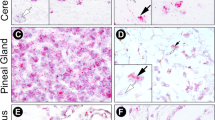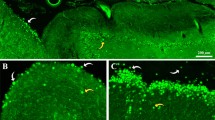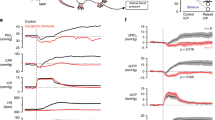Abstract
Diehl and Neumann1 have determined the content of ascorbic acid in the various portions of the human brain and found a characteristically high content in the autonomic centres (tuber cinereum and medulla oblongata). By means of the histochemical method the neurosecretory nuclei of the hypothalamus were reported to contain many silver granules due to reduction of silver nitrate by ascorbic acid2–4. Although in the above chemical and histochemical reports particular attention was not paid to the locus coeruleus, the locus was recently found by a histochemical method (Shimizu et al. 5,6) to demonstrate the pronounced activity of monoamine oxidase, and by several physiological investigations7–9 to regulate respiration, as the pneumotaxic centres. As the locus coeruleus was thus supposed to display some autonomic (visceral) functions, which might be related to amine metabolism, we thought it reasonable to search for the histochemical presence of ascorbic acid in the locus coeruleus.
This is a preview of subscription content, access via your institution
Access options
Subscribe to this journal
Receive 51 print issues and online access
$199.00 per year
only $3.90 per issue
Buy this article
- Purchase on Springer Link
- Instant access to full article PDF
Prices may be subject to local taxes which are calculated during checkout
Similar content being viewed by others
References
Diehl, F., and Neumann, H., Klin. Wochenschr., 18, 418 (1939).
Schiebler, T. H., Acta Anat., 13, 233 (1951).
Sloper, J. C., J. Anat., 89, 301 (1955).
Imoto, T., Arch. Hist. Jap., 13, 491 (1957).
Shimizu, N., Morikawa, N., and Okada, M., Z. Zellforsch., 49, 389 (1959).
Shimizu, N., and Morikawa, N., Nature, 184, 650 (1959).
Johnson, F. H., and Russel, G. V., Anat. Rec., 112, 348 (1952).
Baxter, D. W., and Olszewski, J., J. Neurophysiol., 18, 276 (1955).
Ngai, S. H., and Wang, S. C., Amer. J. Physiol., 190, 343 (1957).
Gomori, G., “Microscopic Histochemistry” (Univ. of Chicago Press, Chicago, 1952).
Lison, L., “Histochimie et cytochimie animales”, 2e éd. (Gauthier-Villars, Paris, 1953).
Mehler, A. H., “Introduction to Enzymology” (Academic Press, New York, 1957).
Fruton, J. S., and Simmonds, S., “General Biochemistry”, 2nd ed. (John Wiley, New York, 1958).
Author information
Authors and Affiliations
Rights and permissions
About this article
Cite this article
SHIMIZU, N., MATSUNAMI, T. & ONISHI, S. Histochemical Demonstration of Ascorbic Acid in the Locus Coeruleus of the Mammalian Brain. Nature 186, 479–480 (1960). https://doi.org/10.1038/186479a0
Issue Date:
DOI: https://doi.org/10.1038/186479a0
This article is cited by
-
The peribrachial region of cat
Cell and Tissue Research (1974)
-
�ber das Neurolipofuscin in der unteren Olive und dem Nucleus dentatus cerebelli im Gehirn des Menschen
Zeitschrift f�r Zellforschung und Mikroskopische Anatomie (1971)
-
Histochemical studies on the morphology of the golgi apparatus and on the distribution of hexokinase, L-gulonolactone oxidase, xylulose reductases, and ascorbic acid in the locus coeruleus of the rabbit
Histochemie (1971)
-
Histochemical Demonstration of Ascorbic Acid in the Substantia Nigra of the Cat
Nature (1962)
-
Histochemical Demonstration of Aromatic Monoamine in the Locus Cœruleus of the Mammalian Brain
Nature (1960)
Comments
By submitting a comment you agree to abide by our Terms and Community Guidelines. If you find something abusive or that does not comply with our terms or guidelines please flag it as inappropriate.



